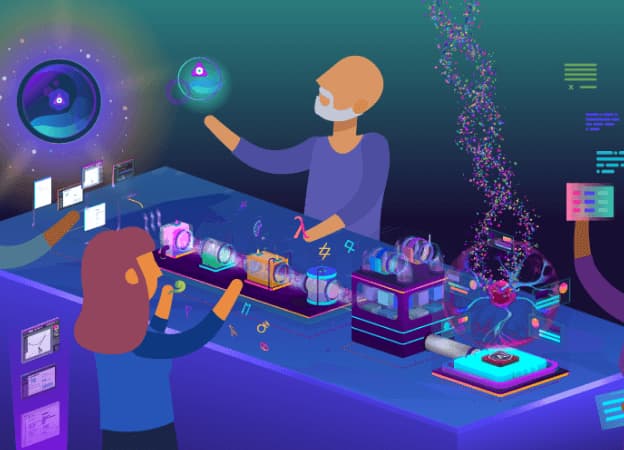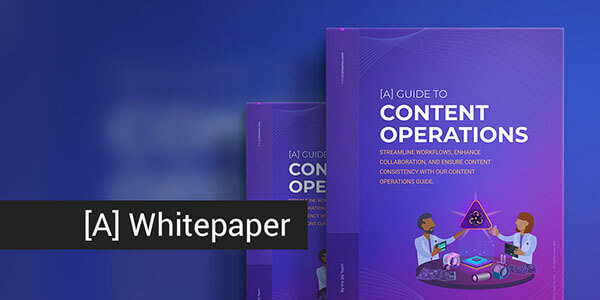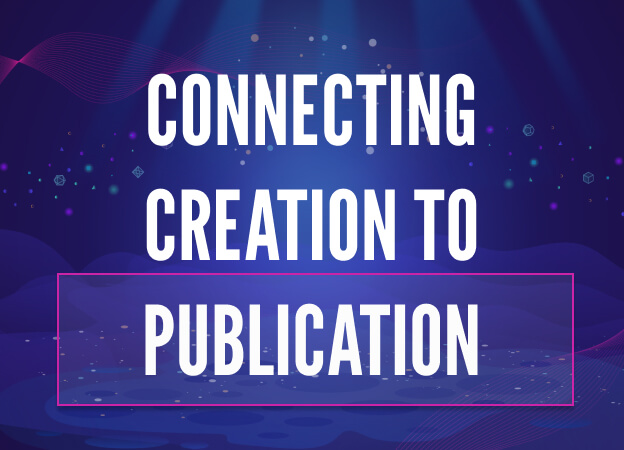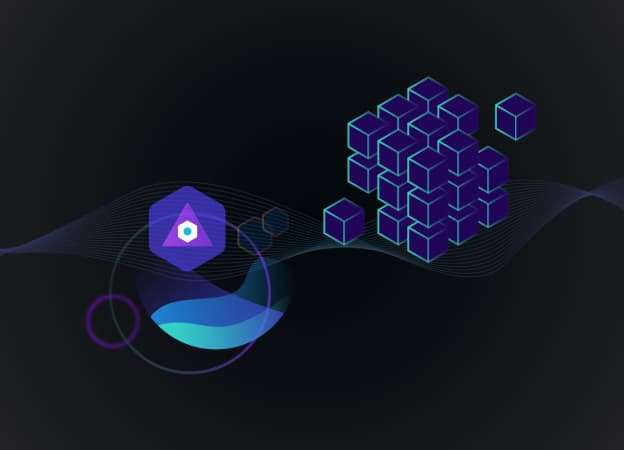Content silos are normal, natural, and unavoidable. They aren’t going away—but they can be bridged with patterns and orchestration. Instead of centralizing content acquisition, we need to plan for a future in which content can move across channels and through supply chains in a fluid manner. [A] works with clients to develop novel architectures for these content supply chains. However, this process requires smooth transformations from point to point along the chain.
Content acquisition, management, and delivery systems lose value without fluid content transformation and management. So, how do we get content moving independent of systems and platforms?
Building a modular, decoupled information system is not an isolated project. Systems fail without people and process integration, as well as change management. The roadmap shows the progression of capabilities needed to achieve an Intelligent Customer Experience.
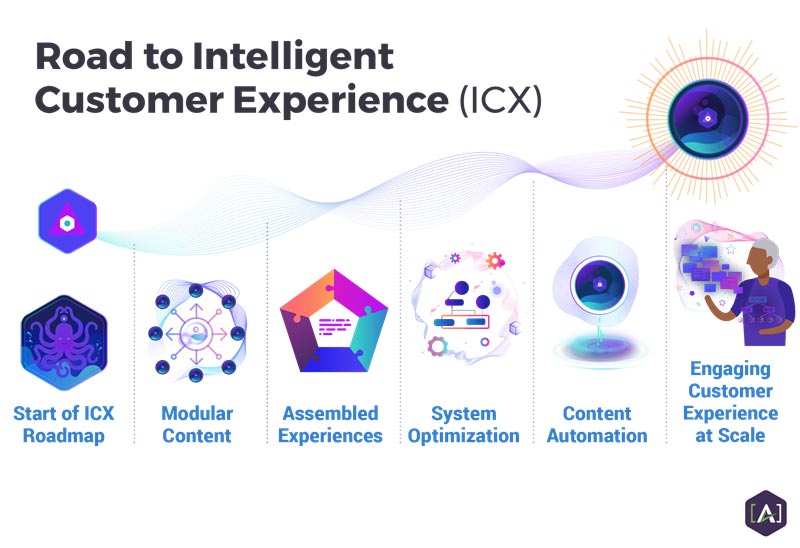
Challenges of acquiring content
Multiple content teams across an enterprise frequently have their own systems and tools for creating and managing content. They lack communication with (and in some cases, knowledge of) each other, and lack a common framework to support the content supply chain. The content itself is often unstructured or incompatibly structured, sourced using multiple different tools, and not well-optimized for localization.
This lack of efficiency costs organizations money in the form of lost opportunities, brand dilution, duplication of effort, redundant tooling, lack of reuse, and friction at each point in the content supply chain. The problem becomes particularly apparent when small issues in the source content and processes are magnified exponentially during localization, reducing quality and significantly increasing costs.
Because these teams have different requirements and responsibilities (and no one wants to give up their shiny new tool), finding “one tool to rule them all” usually only works in theory. What does work is accommodating these disparate needs within a common, flexible framework that allows each team the autonomy needed to fulfill their mandate, while reducing friction in the supply chain and facilitating resource sharing when it makes sense to do so. Having a common, flexible framework has the added benefit of providing a more cohesive, consistent customer experience as well.
The Problem with Misaligned Content Models
Incompatible formats and structures don’t just happen upstream where we acquire content. The tools that we use to move content from one system to another often don’t align either. What we capture from the author often has to be converted or transformed into some other state for systems down stream, whether that’s a storage format like XML or a presentational format like HTML or JSON. Because organizations often do not coordinate content structure across departments, movement of content along a delivery pipeline often creates friction, if not outright blockage, to delivering on-demand content in a form appropriate to all channels. Without alignment of content models across the organization, transforms break and the flow of content stops dead.
Most companies do not coordinate content modeling efforts among the various organizations and departments producing content across the enterprise. When the same channels are used to deliver content developed using separate content models (or worse, no content models), the content can look inconsistent and sloppy, and the effort to transform it for presentation can result in duplicate effort. Lack of consistent content structure also produces sub-optimal customer experiences across content sets.
Somehow, we need to bridge silos and bring some central coordination to content-modeling efforts. We need to make content models a focused, central asset in our organizations, with a Core Content Model.
Introducing the Core Content Model
The Core Content Model is [A]’s methodology for creating and maintaining a centralized content model that coordinates structured content development for an enterprise and then aligns all expressions or forms that structured content needs to take in all systems, through all transformations, and in all channels.
To develop this model, we first identify all content types for the domain we’re modeling. We begin with the abstract structure of the content types based on extensive content analysis. Considerations for presentation are set aside during this process, allwoing us to focus strictly on the content structure and semantics that will inform our model. We then step through each phase of the content delivery pipeline—content acquisition, management, publication, and delivery—and we determine how the expression of that content model looks for each stage. So, we might acquire content in some semantically rich form of XML markup, like DITA or DocBook, and that might also be the form in which we manage and maintain the content.
We can also use form-based authoring interfaces that can be transformed into XML markup prior to import into a content management system. As long as we know how each of those elements maps to our content model, we can plan for transformation from one expression to another, such as DITA, HTML, Schema.org, or JSON. And that can work even if we’re acquiring content from semistructured forms like styled Microsoft Word docs or Markdown.
This Core Content Model becomes the means by which we orchestrate content transformation across our entire enterprise. So, what we deliver to our channels is acquired, managed, and maintained consistently. Any changes to the model in one place can initiate updates in other places along the content delivery pipeline.
Architecture for Intelligent Customer Experiences
Content intelligence requires a more sophisticated content system architecture than traditional publishing processes provide. The more we cling to old methods and approaches for content delivery, the less agile our content will be, and the less scalable the customer experience. What’s more, we lose the opportunity to automate time-wasting manual processes that bog down content delivery.
We need systems that talk to each other. The Core Content Model gives us a common language, and a Rosetta Stone to enable comprehension among systems and tooling. However, if the systems and tools don’t integrate and allow for hand-offs and transformations, we will be back to manually moving content from system to system and manually reformatting (read “cut and paste”) to prepare content for different channels. Content intelligence requires intelligent system architectures.
One way that companies trap themselves into suboptimal experiences for authors and for intelligent content is by selecting systems that lock them into a particular vendor, in particular those systems in which authoring and content storage are tightly coupled. Many web and headless content management systems operate on this model. They give us few options for producing semantically rich structured content, and often force authors into a one-size-fits all approach. Often, these systems do not provide the range of opportunities that companies need without integration with other tooling: personalization engines, master metadata management systems, semantics platforms. And, on their own, they can’t meet the needs of an omnichannel world. They’re still exclusively delivering websites while the content delivery ecosystem has expanded to an omnichannel world.
We need to have appropriate component content management (CCMS) with decoupled authoring capabilities to allow content acquisition from numerous sources. We need workflow management, centralized collaborative review capability, reporting and data analytics. A good CCMS can provide all of this. Several cloud-based CCMSes can be licensed on a subscription basis and provide a lower cost entry point than some of the bigger customer experience platforms.
We also need to stop trying to manage translation the old fashioned way. Translation memory is great technology, but if we’re still manually managing localization projects, we can’t scale. We need to integrate our CCMS with translation management systems, many of which have connectors for the more popular systems. And again, several cloud-based solutions provide subscription offerings.
We need to look seriously at delivering solutions based on Content as a Service (CaaS). Doing so enables channel developers to access content via RESTful or graph APIs and assemble them into experiences for their clients. Structure and semantics enable these personalized, on-demand experiences.
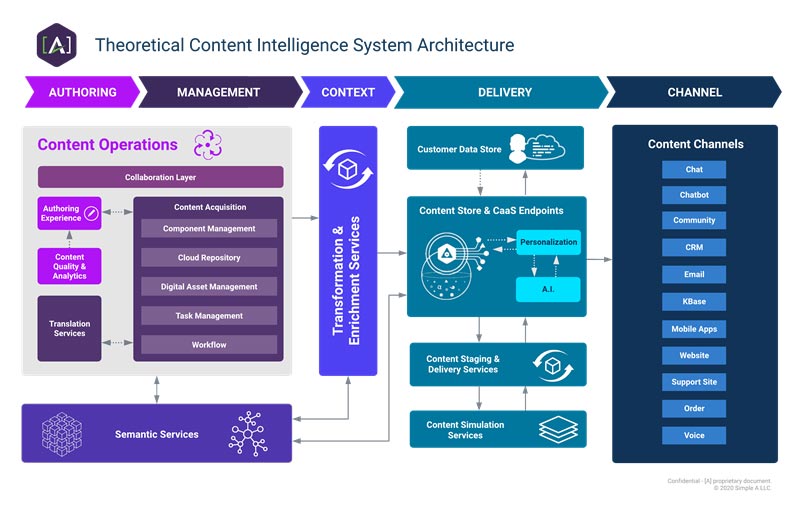 This diagram illustrates a theoretical content intelligence system architecture with the various components that might entail. A live architecture might include different combinations of components and different configurations, but a mature architecture will address each of the stages along the content delivery pipeline to one degree or another. Scalable omnichannel delivery requires it.
This diagram illustrates a theoretical content intelligence system architecture with the various components that might entail. A live architecture might include different combinations of components and different configurations, but a mature architecture will address each of the stages along the content delivery pipeline to one degree or another. Scalable omnichannel delivery requires it.
Aligning organizations on a single content vision
Even in organizations with C-level sponsorship and adequate budgets, the journey toward the intelligent customer experience is challenging, and requires that the organization is committed to the following:
- Change management: The number one reason that big initiatives fail is poor change management. No amount of technology will solve people and process problems, particularly when we are asking teams to approach their work and each other in different ways than they are used to. Take a proactive, human-centered approach to managing the change, building on what’s working and on the organization’s strengths.
- Enterprise content strategy: To gain efficiency and alignment across the content organization, the teams need a shared vision of why they are doing this and what they are doing. Strategic planning for content needs to happen above the product team level, and often even above the business unit level. The shared vision, tied to organizational strategic goals, then drives the implementation across the organization. In large organizations, the content strategy team might set up advisory councils, composed of key stakeholders to ensure that the content strategy stays on track.
- Governance framework: Lifecycle governance, a reuse strategy, semantics governance model, style guides, and an interoperability plan significantly reduce the issue of content incompatibility across the organization, while strengthening the brand, as well as improving quality and consistency of the customer experience.
- Metrics that support clearly defined success criteria: As the old adage goes, “If you can’t measure it, it didn’t happen.” While it can be challenging to directly measure content outcomes, we need to clearly define success criteria and ensure that we collect metrics that show how well we meet those criteria. Without metrics, we have difficulty proving the value to the C-level and getting the funding we need to ensure that the content services organization can meet the demands of today and tomorrow.
Content strategy, operations, and engineering come together in the Content Orchestration Model (COM) to facilitate this alignment throughout the content supply chain and across each layer of activity needed to create quality content that meets the needs of our customers, wherever they live and work, and in whatever channel they come to us. The COM acts as a guidepost as we develop and maintain these complex systems.
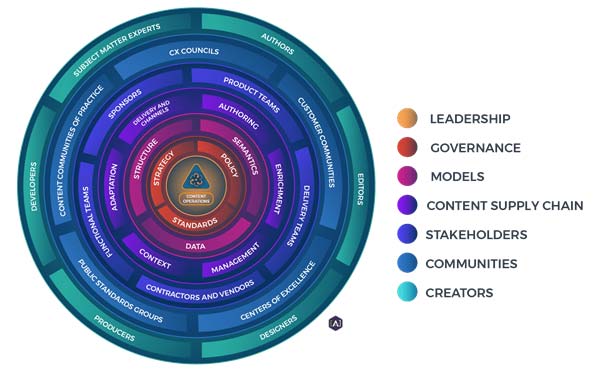
Conclusion
By taking a holistic approach to content systems, we can build strategies that lead to flexible frameworks for content engineering and operations. Aligning content operations and engineering allows us to present a unified front and singular, intelligent experience, which is expected by customers in our ever-changing digital landscape.
